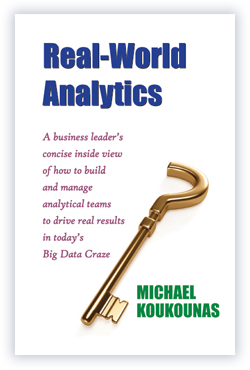I knew that there was a good chance that I was going to enjoy Michael Koukounas’ book entitled Real-World Analytics when I read Koukounas’ dedication to his wife. He wrote that she encouraged him “to write about a subject she has absolutely no interest in.” From that dedication, I assumed the book would be both grounded in reality and interesting. I wasn’t disappointed. The book is an easy read filled with anecdotal examples of what works and what doesn’t when trying to implement a big data project. In this era of big data, Koukounas reminds us, “All these data only becomes meaningful if someone can interpret them, segment them, analyze them, and sometimes use them to predict a useful outcome.” The primary premise of his book is “that building and managing analytical teams is not easy.” That’s where the “real world” part of his recommendations comes into play. He writes, “Talented folks — smart as they are — often don’t know how to develop analytical solutions that are both efficient and implementable.” The book is focused on helping managers understand the right things to do and the nasty things to avoid when assembling analytical project teams.
Koukounas isn’t an academic. He is a hard-headed businessman with decades of experience from which he draws. In the book he offers the following:
- Four key elements that drive strong, implementable analytics.
- How to apportion the key responsibilities in designing an analytical organization.
- Six steps to developing successful analytics.
At a time when the buzz about big data is at its height, you might expect Koukounas to explain why a good analytical project should start with the data. The fact of the matter is that he says starting with the data is exactly the wrong thing to do. He indicates that starting with the data is a mistake that many analysts make. He writes:
“I regularly see organizations caught up in the Big Data obsession, this up-to-the-minute gold rush in which far too many people, data scientists and business managers alike, believe that there is gold in all those new and growing piles of data — and that, if only they can crack the code with the right statistical tool and some ingenuity, they will discover millions of dollars of value. Please don’t take my reservations over this data craze as a vote against data and analytics. Quite the opposite; I have built a career on using data and analytics to drive multi-million-dollar impacts if they are executed with an understanding of how they are to be implemented.”
Koukounas goes on to explain that good analytics achieve the right results because they reflect an understanding about how the real world works. He defines analytics as “the practice of discovering meaning in data.” Obviously, if you don’t understand how the real world works your analytics are meaningless. Koukounas’ real-world approach to analytics is summed up this way: “Business analytics use data to make better decisions.” He provides a few examples:
- CEOs make strategic decisions about whether to bring products to market.
- Risk Managers decide which loans to accept.
- Marketing teams decide which offers to present, and to which customers.
He notes, “All of these decisions can be made more efficient with analytics.” At the heart of his recommendations for developing a successful analytics program is a method he calls ATOM that helps develop organizational capacity. ATOM stands for: Access to Data; Talent; Operational Knowledge; and Maintenance. In the book, Koukounas explains what is involved in each of these areas, why they are important, and how you can build that capacity in your organization. In fact, he dedicates a chapter to each element. If you don’t read anything else in the book, you should take the time to read the chapters on Operational Knowledge and Maintenance. In the former chapter, Koukounas reports that he has seen many analytical projects fail because the people involved “didn’t understand the operational environment and business domain that they were trying to use analytics to help.” He continues:
“The lack of operational and domain expertise shows up in two areas of the analytical process:
- Analytical Design: When setting up an analytical design will solve the business issue defined.
- Insights: When interpreting the results of an analytic to identify insights that will drive business impact.”
Koukounas begins his chapter about Maintenance by stating, “Maintenance is the part of analytics that is most often neglected but that is absolutely required.” I am in total agreement with that assertion. Another section of the book that shouldn’t be ignored is Koukounas’ discussion of the types of analytical talent you need to assemble on project teams. He believes there are five categories of responsibility that need to be covered by individuals with specific talents. They are:
- Analytical Consultants.
- Deep Analytical Talent, including (a) analysts who work on on-and-done projects and (b) analysts who work on ongoing strategy development.
- Analytical Maintenance.
- Data Management.
- Research and Development
Koukounas devotes a chapter to each category. The end of the book is dedicated to discussing six steps to developing successful analytics. The first step is critical: Defining the problem. In my experience, the best analysts are the ones who ask the best questions. Koukounas states that “business problems usually come in the form of a question.” The better the question the better the chance that a good answer will be found. He provides a few sample questions:
- Who are my best or worse customers?
- What offers should I make them, and when should I make them?
- Why are my customers leaving?
- Which of our transactions are fraudulent?
- Who is influencing our customers?
- Where should I locate my next store?
He goes on to note, “All these questions reflect business problems across many industries. Without a well-defined problem, most analytics merely waste time and resources.” Koukounas concludes:
“Only after [organizations] are able to target analytics to a defined business problem, and understand — through the idea of Touch Points, how and where the results will be applied — can analysts profitably begin to consider the data that will best fit the analytics that have been defined.”
There are lots of other jewels in the book worth discovering. The $22 asking price for a 158-page book is a bit steep; but, anyone tapped with assembling an analytics team will find the book a bargain.





